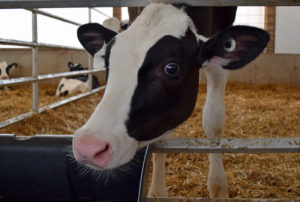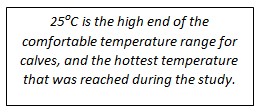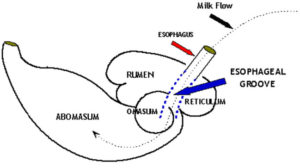Healthy Calf Conference
Follow to stay up-to-date on all Healthy Calf Conference updates. Speaker announcements, sponsorship information, registration announcements, and more.

Producers often postpone providing water to newborn calves. This is especially true in the winter, when freezing temperatures mean providing fresh water to calves can sometimes become a challenging chore. It is typically assumed that calves get enough hydration from their milk/milk replacer, so don’t need water during the first days of life. According to research, milk replacer is not a sufficient water source for young calves.
A 2018 study by Wickramasinghe et. al. provided one group of calves with free choice fresh water from the first day of life while another group received no water until day 17 (the average age U.S. farmers first provide water to calves). The study provided free choice milk/milk replacer as well as starter to ensure calves were drinking water because they were seeking out water specifically, and not just because they were looking for more milk.
Newborn calves in the study drank about 0.75 litres/day (L/d) of water during the first sixteen days of life. After day 17, calves were drinking about 0.82 L/d. Once calves were fully weaned (49 days of age), they consumed about 5.3 L of water daily. The age at which water was introduced had no impact on incidence, severity, or duration of scours.

In both groups of calves, for each 1⁰C increase in ambient temperature (up to 24.8⁰C), average daily gain increased by 20 grams (g). Ambient temperature also had a significant impact on water intake. With each 1⁰C increase in temperature, water intake increased by 68 milliliters (mL) preweaning, and 55 mL post-weaning. During weaning, water intake per 1⁰C temperature increase jumped to 141 mL. This further emphasizes the importance of fresh water for all calves in warm temperatures.
Even when calves could drink more milk, they choose to drink some water. This indicates water access is important, even for very young calves. When calves receive less milk/milk replacer, access to water may be even more important, as smaller amounts of milk may not be sufficient to fill the daily liquid needs of the calf.
As expected for calves on ad libitum milk, starter intake overall was low during the pre-weaning period. Calves were weaned on day 42 with a step-down process by offering 3.2 L of milk once per day (down from 3.2 L three times per day). As this is a significant drop in milk and calves were only eating small amounts of starter, all calves experienced a growth lag at weaning. A more gradual weaning process would have reduced the impact of weaning on calf growth. As expected, starter intake increased sharply for all calves at weaning.

While less than a litre of daily water intake may not seem like much, where the water ends up may be important. When a calf drinks milk or milk replacer from a bottle, the milk passes the rumen and enters the abomasum – this allows the calf to effectively digest the nutrients in milk. Meanwhile, when a calf drinks water from a bucket, the water enters the rumen. Water in the rumen impacts rumen development, the rumen microbiome (microorganisms that help the rumen digest nutrients), pH, mixing, passage, and volatile fatty acid composition.
Calves offered water from birth in this study had improved Neutral Detergent Fibre (NDF) and Acid Detergent Fibre (ADF) digestibility at 10 weeks of age. This suggests superior rumen function for these calves. Combined with increased body weight after weaning, these results suggest early access to water better prepared the rumen (and the calf) for weaning.
Calves that had water from the first day of life tended to have a higher body weight and heart girth (measurement of calf around the chest just behind the elbows, an indicator of growth/body weight) before weaning. Caves with early access to water also had a greater hip height and body length. These results indicate that calves with early water access have better structural growth. Structural growth has been linked to future body weight and milk yield. Stroet et. al. found that calves with an average hip height of 81.1 centimeters (cm) or more produced an average of 3.2 kg/day of milk per day than those with an average hip height of 77.6 cm. A slower growth rate also reduced the likelihood of a heifer remaining in the herd until the first lactation, but this may be linked to the fact that sick calves generally grow more slowly or experience growing lags.

Calves drink a significant amount of water as early as one day of age. Water intake can translate into improved growth performance before and after weaning by enhancing rumen development and nutrient utilization efficiency. After weaning, water intake increases along with starter intake. Providing calves with access to fresh water from the first day of life is one of the easiest and cheapest management practices to encourage calf growth.
Follow to stay up-to-date on all Healthy Calf Conference updates. Speaker announcements, sponsorship information, registration announcements, and more.
The Codes of Practice are nationally developed guidelines for the care and handling of farm animals. They serve as our national understanding of animal care requirements and recommended practices.